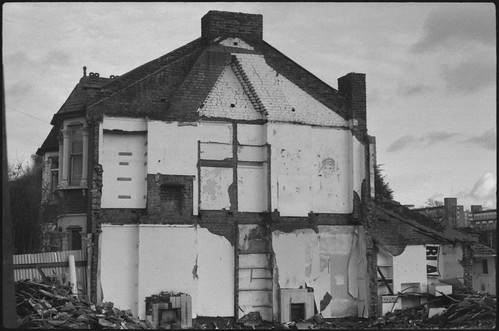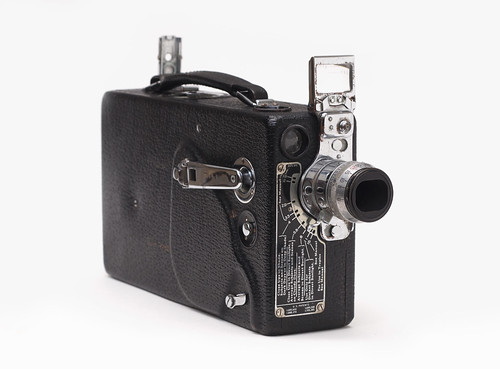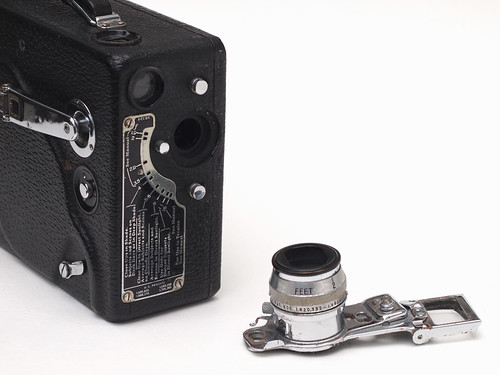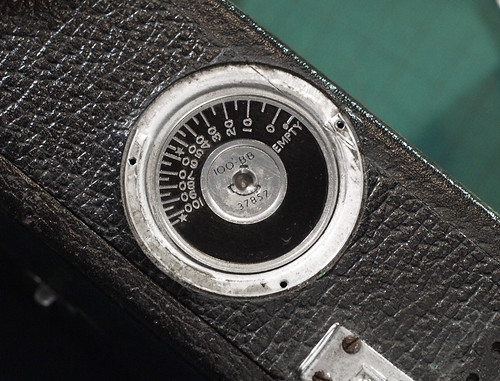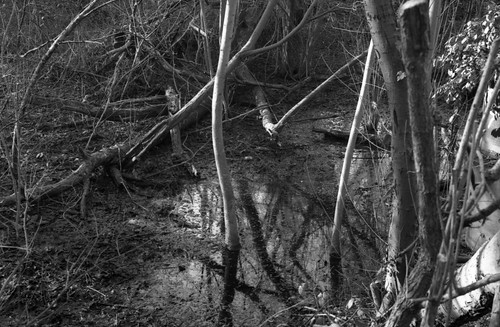 |
| Dyers Hall Road, Leytonstone, 31st December 1993 |
In a post that I wrote for this blog ten years ago, 'Twenty Years Since', I mentioned–almost in passing–photographs taken of houses being demolished to make way for what was then called the M11 Link Road, now the A12. The few words that described the experience of taking these photographs belies what was, in retrospect, an important formative experience or experiences. The taking of the these photographs was tied up with learning the craft of photography itself, following a basic introduction to photography as part of my Foundation Course in Art & Design a few weeks earlier, then receiving a secondhand Praktica BCA for Christmas in 1993.
I had been aware of the planning blight that accompanied the road scheme years earlier, although I hadn’t known that this was what it was. A journey into central London would involve taking the Central Line from Gants Hill or Redbridge stations; this branch of the Central Line is in a tunnel under Eastern Avenue, resurfacing just before Leytonstone station for a couple of stops, making this brief view from the windows of the tube train a diverting contrast to the darkness of the rest of the way. Houses backing on to the line where it runs above ground here had begun to be demolished or fall into disrepair years earlier: I distinctly remember the graffiti spelling out WHY BOTHER? on the back of a house from the late 1980s, later to provoke the rejoinder WHY NOT? (These were then joined by CRAWLING KING SNAKES KICK YO ASS.)
What had been an occasional journey while I was at school in nearby Wanstead became a daily one when I started college in 1993; I was all the more aware then that the demolitions were something that was actively happening, rather than what might have appeared to be a few streets fallen into desperate disrepair that I’d see whenever travelling into town. The protests around the tree on George Green in the autumn term was the moment that the active resistance to the road scheme made itself felt. (Rather pointlessly, one night after being kicked out of The George with a friend, we pulled down a fence post that had just been put up around the tree–there appeared to be no security at that stage–delaying the construction of the road by what must have been minutes at best, my only attempt at direct action).
The weather around Christmas in 1993 had been largely cold and wet, with some snow; the last day of the year, a Friday, turned fine and sunny, prompting me to decide that it was the perfect opportunity to use my new secondhand camera, with a roll of Ilford HP5 Plus bought for a holiday college project, which was to illustrate a number of words that we had been given. The photos are a record of that change in the weather. I took the tube to Leytonstone, and walked to Leyton, taking photographs along the way. I took some photographs in the British Museum afterwards on the same day; the last two photographs of the M11 Link Road sequence were taken from a moving train. These may have been from Leyton in the direction of Stratford, or I think I may have taken an eastbound train from Leyton back to Leytonstone, before then switching over (or under as the case is at Leytonstone) to take a Westbound train to Tottenham Court Road for the museum.
I returned on a number of occasions in the following months to take more photographs, neither systematic not comprehensive, but with the awareness that this felt like something of which it was worth making a visual record (the one time that I chanced upon evictions happening on Claremont Road in the summer of 1994, I had a part-used roll of film in my camera and no spare). The photographs were printed in the darkroom at college, rather inexpertly, and the images ended up used in artwork then, in collages and paintings, and I drew on these the following year when I’d left London and started a degree in Fine Art.
 |
| Dyers Hall Road, Leytonstone, 31st December 2013 |
I had occasion to revisit these photographs earlier this year, and needed to find the original negatives; in doing so I also found a set of negatives from 2013 in which I had attempted to match the locations from the photographs of what was then twenty ago as closely as possible. These negatives weren’t scanned at the time–I had intended a blog post then–and the moment passed. I had scanned the original negatives in 2007, and had posted these online in 2008, and rather over-promised the content of these images by calling this the ‘M11 Link Road Archive’ (an actual archive of material related to the M11 Link Road and the protests resides at the Museum of London). Returning to some of the original files, the quality of these original scans was relatively poor, with scanning artefacts and clipped highlights and shadows in many of the frames. (Scanning issues–software and hardware–partly explain the absence of posts on this blog this year, although the main excuse was the writing up of my PhD). Having found the negatives from both 1993 and 2013, I was able to scan these recently with better results for this post.
What I didn’t know at the time was that many of the houses along the route were or had been inhabited by artists. Acme Studios had been offered a number of the compulsorily-purchased houses by the Department of Transport in the 1980s; by the time I was taking these photographs, the houses along the route were occupied by the few original residents who had not moved away, some of the Acme artists who became involved in resisting the demolitions, and the first wave of anti-roads protestors, some of whom had come from Twyford Down, just outside Winchester–where I was going on to study–and many subsequently moved onto to protest the Newbury Bypass after the M11 campaign.
For a few years I probably didn’t think about this part of my life very much; I happened to cycle over the road on the Quartermile Lane bridge from Hackney just before it opened in 1999. I didn’t have a camera on me at the time, and thought I’d return to take photographs of the empty road, but I never did. Then in 2003, a site-specific sound piece by the artist Graeme Miller called LINKED was installed along the route. This required collecting a radio receiver and headphones, available from local amenities–we got ours from Wanstead Leisure Centre–and walking a route from Wanstead to Hackney Wick, along which one would encounter transmitters that broadcast audio loops consisting of extracts of oral history weaved with music into soundscapes.
Related to Miller’s LINKED, in 2008 I attended a number of seminars at LCC’s Photography and the Archive Research Centre (PARC), part of their research project Road: Artists and the Stop The M11 Link Road Campaign, 1984–1994; the ninth issue of PARC’s journal, Fieldstudy, was devoted to this research project, and featured a few of my photographs from 1993-94. Last year, Graeme Miller revisited LINKED: since its initial installation, with most of the receivers being placed on lamp posts along the road, a slow attrition had reduced these in number over time, some going as the Hackney Wick end of the route was swallowed up by the 2012 Olympic Park, others from the streetlights being knocked over, or the transmitters being unknowingly discarded by contractors. In anticipation of the project’s 20th anniversary, Miller revisited it for Re-LINK last year where the receivers were made available again for 48 hours and a roundtable discussion was hosted by Leytonstone Library; in conjunction with the exhibition Radical Landscapes at the William Morris Gallery, three open days for LINKED were planned, the first was in November, the next on 20th January and 17th February 2024. (In the intermediate years I had other opportunities to revisit Miller’s LINKED a few times, re-walking the route in different groups, thanks to the artwork being used as a PhD case study by Dr. Sarah Wishart.)
In 2013, attempting–as best I could–to find the same viewpoints as the photographs taken in 1993, it wasn’t always clear as to where exactly each picture had been taken then: I hadn’t taken any notes. However, the sequence on the contact sheet, and the linear nature of the route from station to station made this relatively easy in most cases, but for some photographs this would have meant hovering above the A12 itself, as with most of those taken along Claremont Road itself. Some of the photographs in my retracings from 2013 and 2014 were taken with a Zenit 11, some with Praktica MTL3, but for both cameras I used a Prakticar f1.8 50mm lens, the same design lens as I would have had on my Praktica BC1, and then the BCA which replaced it later in 1994 (Edit 25/01/24: Having rediscovered the contact prints from the photographs taken on the 31st December 2013, I had actually used an Olympus OM10 for this set of photographs).
For the pedestrian, or cyclist, the two ends of Dyers Hall Road are joined by a footpath and cycle lane which runs alongside the brick wall of the A12 here. At the end of Dyers Hall Road South, there is a footbridge that crosses the A12 to Norman Road on the eastern side; there had been a shorter footbridge here in 1993, which afforded a view across cleared ground to the railway bridge, a section of its brick arches already replaced by a long straight steel span.
A second photograph from the bridge looks over back gardens on Dyers Hall Road; the houses in the background face onto Grove Green Road. I took one photograph in 2013 looking across from the far end of the bridge towards the rear of those same houses on Grove Green Road, but a truer position would be on the footbridge itself, just past the line of the railway, where the previous footbridge would have ended–as in the third image below.
The next photographs are from Claremont Road, which became the focus of protest in 1994. The first of these are at the end of the right angle where it comes off Grove Green Road, two houses, one with a gibbet fixed to a chimney and a poster in a window: M11 LINK ROAD/DEVASTATING OUR COMMUNITIES. I’m reasonably sure that these houses were at the northern end of the road: the fence that runs alongside borders the Central Line. Behind would have been the Cathall Road bridge over the railway. In 2013 I took two photographs looking in the same general direction, one from that bridge, which would be somewhat behind the location of these houses, the other from the wide pavement before the bridge, which would be to the west.
A photograph of a house with a front door, curtains and a cat painted on breeze blocks is one of the pictures that would now be entirely where the A12 is now, or above, as the road sits in a cutting here.
There are two photographs at the southern end of Claremont Road where it turns back to Grove Green Road. After the A12 was built a small section of the southern end of Claremont Road remained; there was a little space here to build some houses, facing onto the road, thus ensuring that Claremont Road as a residential address still exists. A photograph looking back from here to Grove Green Road roughly replicates the same view of that from 1993.
The next photographs are from Colville Road. This was set a little further back from the Central Line than Claremont Road: houses which backed onto the railway were all demolished, along with some houses facing those at its northern end, where the angle of Colville Road was changed to accommodate the A12, running behind its brick wall but a stretch of terraced housing on the road’s western side survived.
This change in the course of the road can be clearly seen in the photograph from 2013 which looks along the wall, replicating a picture from 1993 looking over the corrugated iron fence to the end of terrace, side-on to the first photograph of Colville Road.
From here another photograph looks across to the Central Line, showing a 1962 stock Central Line train passing St. Patrick’s Roman Catholic cemetery in the far background (these trains, which I had grown up with, were phased out during that year I spent commuting on the Central Line, going to college, replaced by the current 1992 stock). A photograph of this view would be straight on to the brick wall; I took a picture in 2013 which I think must be looking up and more to the right.
There are two photographs from 1993 that mark the end of the walk from the entrance to the rail yard that lay to the southwest of Leyton Station; this would seem to extend down to Temple Mills, although I haven’t been ably to find whether Leyton Rail Yard was separate from that of Temple Mills, which is now the Eurostar depot. The view from here shows the horizon opening up to take in a skyline in which one can see One Canada Square in Canary Wharf, new in 1993 and the tallest building in the country at that point, past three tower blocks by Bow Church station, the Bryant and May match factory, across what is now the 2012 Olympic Park, marked by the two squat UEL residential towers, to the tower blocks clustered around Wick Lane and Victoria Park. The view now is almost entirely different: trying to locate the exact viewpoint would take one to the edge of the Leyton Mills retail park; slightly to the left, on the bridge over the A12 itself, shows a broadly similar view to that of 1993, with most of the horizon filled with development on the 2012 Olympic site. One Canada Square can still just be seen, as can the tower blocks by Wick Lane.
A second photograph in 1993 was taken at right angles to the first, looking back towards Leyton station, dominated by railway buildings facing the rise in the high road as it passes over the railway line; the current station building’s roof can just be see to their left, mostly obscured. A similar view today looks across the ramp and stairs into the retail park, with the station’s pitched roof in roughly the same position. I didn’t try to replicate the two photographs shot from the moving train in 1993, as I couldn’t be at all sure exactly where they were taken.
Although never directly involved in the campaigns and protests, not knowing about the community of artists there, feeling like an outsider despite it being relatively local, seeing and recording the progress of these demolitions in 1993 and 1994 affected me in part I think as the houses were very much like that I had grown up in, and was something that I could see happening as I took the tube to college every day. There was also an aspect of being confronted by the arbitrary use of the power of the state at this formative age, bound up as it felt at the time with the Criminal Justice Bill, much in the news at the time, passed into law in November 1994, with many of its measures seemingly targeted at the young and politically active, and how this galvanised, pre-internet, before social media, a grassroots opposition (Labour, under Tony Blair–first as shadow home secretary as the bill made its way through parliament, then as leader of the opposition following John Smith’s death–abstained when the bill received its third reading). My awareness of this came through a very different media ecology from today: posters on the streets, what alternative press I happened to come across, like SchNEWS, but mostly how it filtered through into the music of the time and the wider conversations around it in part through the ‘polytextuality’ (as Dean L. Biron describes it) of the music’s physical artefacts–the artwork and liner notes–and how this was reflected in the music press and the conversations that were part of meeting new people, new ideas, starting a college course, anticipating leaving home. When I took the photographs on the last day of 1993, photography was physical (it would be many years before I even saw a digital camera, though I did have my first experiences with Adobe Photoshop then, with a faint intuition that this would be a transformative technology), enabling me to return to the negatives thirty years later and create images anew from their matrices.
Fieldstudy issue 9 (PDF file)
Graeme Miller LINKED
Sarah Wishart, 'A Provenance of Performance'
SchNEWS Issue 3 December 1994
Dean L. Biron, 'Writing and Music: Album Liner Notes'

















